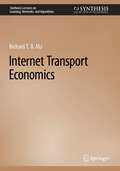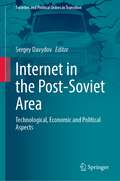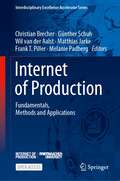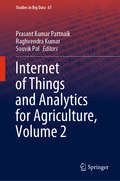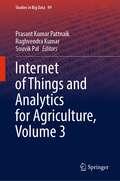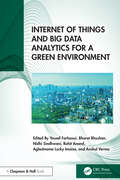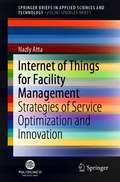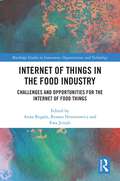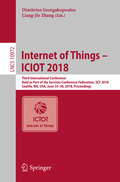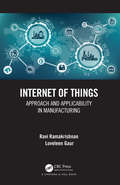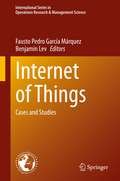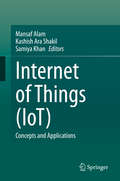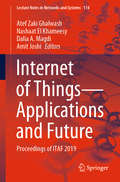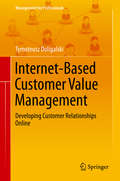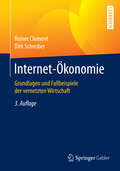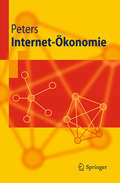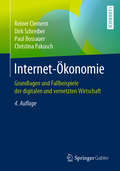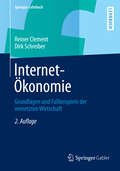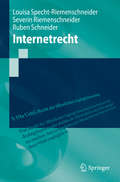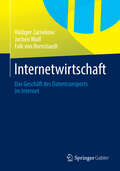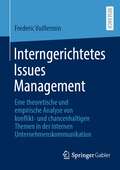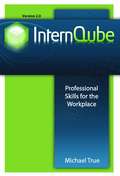- Table View
- List View
Internet Transport Economics (Synthesis Lectures on Learning, Networks, and Algorithms)
by Richard T. MaThis book presents Internet transport economics as a new approach to understanding the packet-switching paradigm of Internet infrastructure as a global transport system for data packets. It is a prescient view of the Internet’s evolution into a content-centric service platform where the quality of services (QoS) cannot be guaranteed due to the tens of thousands of autonomous systems that enact business decisions on peering, routing, and pricing in a way that determines aspects of the Internet ecosystem like network topology, latency and throughput of traffic flows, and performance of network applications. The trafficking issues created in this environment are a critical concern and barrier for user applications that require real-time responses, such as telesurgery and teleoperation of autonomous vehicles, and the book presents the Internet transport economics model as the solution. While engineering and business are the prevailing lenses through which the Internet is viewed, the book builds its methodological framework around transport. Further delving into economics, it establishes how the Internet can be understood as providing transport services for data packets, whose demand and supply are driven by the QoS metrics of delay and loss, which can be regarded as congestion costs that result in equilibrium rates of traffic flows sent by content providers (CPs). The book goes on to present a stylized model of content provider-to-access provider (CP–AP) service as well as congestion equilibrium and rate equilibrium solution concepts under the Internet transport economics framework. These are used to analyze the problem domains of service differentiation, market structure, and data pricing. Finally, it discusses various potential future applications. This book will be of interest to graduate students and researchers in areas of computer networking and performance evaluation.
Internet der Dinge in der Intralogistik
by Willibald Günthner Michael Ten HompelExperten aus Wissenschaft und Technik fordern ein Umdenken in der Intralogistik: weg von durchgeplanten, vorherbestimmten Systemen, hin zu einem Netzwerk gleichberechtigter Einheiten, die keiner übergeordneten Koordination bedürfen. In dem Band werden die notwendigen Komponenten, die Softwarearchitektur und die Potenziale dieser neuen Technologie beschrieben. Anwendungsbeispiele liefern Entwicklern und Planern eine Grundlage für die Gestaltung moderner Materialflusssysteme in der Industrie.
Internet in the Post-Soviet Area: Technological, Economic and Political Aspects (Societies and Political Orders in Transition)
by Sergey DavydovThis book offers a comparative perspective on the technological, economic, and political aspects of Internet development in the post-Soviet countries. In doing so, international experts analyze similarities and differences in various countries throughout the chapters.The volume consists of two parts. The chapters of the first part examine the post-Soviet area as a whole. The second part includes specific case studies on the development of the Internet, either in individual countries or in groups of countries. Countries analyzed are Estonia, Ukraine, Russia as well as three Central Asian countries: Kazakhstan, Uzbekistan and Tajikistan. Topics covered in the volume include, but are not limited to measurement, dynamics, and structure of each national Internet audience; the history of the Internet in the post-Soviet countries; development of infrastructure; Internet regulation and institutional aspects; online markets such as telecommunications, online advertising, e-commerce, and digital content; social and cultural aspects; as well as the transformation of the national media systems. This book is a must-read for students, researchers, and scholars of political science and economics, as well as policymakers and practitioners interested in a better understanding of Internet development in the post-Soviet area.
Internet of Production: Fundamentals, Methods and Applications (Interdisciplinary Excellence Accelerator Series)
by Matthias Jarke Christian Brecher Günther Schuh Frank T. Piller Wil van der Aalst Melanie PadbergThis seminal compendium, available through open access, illuminates the forefront of digital collaboration in production. It introduces the visionary concept of the Internet of Production (IoP), an ambitious initiative by Germany's esteemed Cluster of Excellence at RWTH Aachen University. This handbook pioneers the integration of data, models, and knowledge across development, production, and user cycles, offering interdisciplinary insights into production technology's horizons with the overall objective to create a worldwide lab.The work is organized into seven key parts, each contributing to a comprehensive understanding of the IoP. Part I lays the foundation with interdisciplinary visions and concepts. Part II delves into IoP's infrastructure, encompassing digital shadows and actionable artificial intelligence. Part III examines materials within the digitalized production landscape. Part IV confronts the challenges and potentials of production processes under novel digitalization methods.Part V focuses on production management with data-driven decision support, while Part VI explores agile development processes. Finally, Part VII delves into the interplay between internal and external perspectives in the IoP, human-centered work design, and platform-based ecosystems.Supported by the German Research Foundation (DFG), this compendium redefines manufacturing through the transformative IoP lens. Embrace this scholarly endeavor to embrace technological advancement. This is an open access book.
Internet of Things and Analytics for Agriculture, Volume 2 (Studies in Big Data #67)
by Prasant Kumar Pattnaik Raghvendra Kumar Souvik PalThis book addresses major challenges faced by farmers and the technological solutions based on Internet of Things (IoT). A major challenge in agriculture is cultivating and supplying high-quality produce at the best. Currently, around 50% of global farm produce never reaches the end consumer due to wastage and suboptimal prices. The book presents solutions that reduce the transport costs, improve the predictability of prices based on data analytics and the current market conditions, and reduce the number of middle steps and agents between the farmer and the end consumer. It discusses the design of an IoT-based monitoring system to analyze crop environments and a method to improve the efficiency of decision-making by analyzing harvest statistics. Further, it explores climate-smart methods, known as smart agriculture, that have been adopted by a number of Indian farmers.
Internet of Things and Analytics for Agriculture, Volume 3 (Studies in Big Data #99)
by Prasant Kumar Pattnaik Raghvendra Kumar Souvik PalThe book discusses one of the major challenges in agriculture which is delivery of cultivate produce to the end consumers with best possible price and quality. Currently all over the world, it is found that around 50% of the farm produce never reaches the end consumer due to wastage and suboptimal prices. The authors present solutions to reduce the transport cost, predictability of prices on the past data analytics and the current market conditions, and number of middle hops and agents between the farmer and the end consumer using IoT-based solutions. Again, the demand by consumption of agricultural products could be predicted quantitatively; however, the variation of harvest and production by the change of farm's cultivated area, weather change, disease and insect damage, etc., could be difficult to be predicted, so that the supply and demand of agricultural products has not been controlled properly. To overcome, this edited book designed the IoT-based monitoring system to analyze crop environment and the method to improve the efficiency of decision making by analyzing harvest statistics. The book is also useful for academicians working in the areas of climate changes.
Internet of Things and Big Data Analytics for a Green Environment
by Bharat Bhushan Anshul Verma Yousef Farhaoui Agbotiname Lucky Imoize Nidhi Sindhwani Rohit AnandThis book studies the evolution of sustainable green smart cities and demonstrates solutions for green environmental issues using modern industrial IoT solutions. It is a ready reference with guidelines and a conceptual framework for context-aware product development and research in the IoT paradigm and Big Data Analytics for a Green Environment. It brings together the most recent advances in IoT and Big Data in Green Environments, emerging aspects of the IoT and Big Data for Green Cities, explores key technologies, and develops new applications in this research field.Key Features:• Discusses the framework for development and research in the IoT Paradigm and Big Data Analytics.• Highlights threats to the IoT architecture and Big Data Analytics for a Green Environment. • Present the I-IoT architecture, I-IoT applications, and their characteristics for a Green Environment. • Provides a systematic overview of the state-of-the-art research efforts.• Introduces necessary components and knowledge to become a vital part of the IoT revolution for a Green Environment.This book is for professionals and researchers interested in the emerging technology of sustainable development, green cities, and Green Environment.
Internet of Things for Facility Management: Strategies of Service Optimization and Innovation (SpringerBriefs in Applied Sciences and Technology)
by Nazly AttaThis book proposes strategies for FM services optimization and innovation, based on innovative models of IoT application and big data management within FM processes, able to support FM stakeholders in: orienting and managing big data flows and their sources (sensor, RFID, etc.); changing FM services demand/offer and developing new approaches to FM agreements; drawing new supply chains based on network approaches; and outlining new profiles of competences for FM stakeholders. The book demonstrates that FM stakeholders (e.g. Real Estate owners, FM providers, service suppliers, etc.) increasingly need new support tools for understanding the features of the current offer of innovative ICT solutions in order to become promoters of FM innovation, and it provides them with an analytical-procedural framework useful for defining and implementing IoT-based FM services.
Internet of Things in the Food Industry: Challenges and Opportunities for the Internet of Food Things (Routledge Studies in Innovation, Organizations and Technology)
by Anna RogalaThe food industry is experiencing a digital transformation across the entire supply chain, from farm to fork. This book offers comprehensive insights into the challenges and opportunities faced, specifically examining the application of the Internet of Things. The authors analyse the benefits and the related threats from the perspective of the participants of the entire supply chain, including consumers. Taking the reader on a journey, this book begins with an analysis of technology use in farming, production, logistics and retailing before delving into the use of digitalization in educating consumers on sustainable consumption practices. The multifaceted analysis of the Internet of Food potential combines science and practice, enriching theoretical analysis with case studies. This book will be of interest to those researching and studying supply chain management, logistics, innovation and technology management and consumption, with a particular interest in the food industry.
Internet of Things – ICIOT 2018: Third International Conference, Held as Part of the Services Conference Federation, SCF 2018, Seattle, WA, USA, June 25-30, 2018, Proceedings (Lecture Notes in Computer Science #10972)
by Dimitrios Georgakopoulos Liang-Jie ZhangThis book constitutes the proceedings of the International Conference on Internet of Things, ICIOT 2018, held in Seattle, WA, USA, in June 2018. The 13 full papers and 1 short paper presented in this volume was carefully reviewed and selected for inclusion in this book. The contributions are organized in topical sections named: Research Track – Architecture; Research Track – Smart IoT; Application and Industry Track; and Short Paper Track. They deal with research and application innovations in the internet of things services.
Internet of Things: Approach and Applicability in Manufacturing
by Ravi Ramakrishnan Loveleen GaurThe concept of Internet of Things has silently existed since the late nineteenth century but in the current decade expectations and excitement has peaked. However not many have understood the profound change that it can usher in. How big this change can be and how it can transform our working!! This book aims to bring in this realization with illustrative and practical case studies with comprehensive concepts. From beginners to practitioners in the field of academics or industry, it serves as a comprehensive yet easy to comprehend source of information on the multiple facets of IoT. Simplistic but comprehensive introduction of the facets of primarily the industrial IoT Practical adoption cases explaining the Core technology stack and business applications Comprehensive view of current technologies which complete the IoT delivery ecosystem, followed by overview of IoT enabled new business models. Realistic view of how industrial firms can evolve into the next stage of maturity along with determinants influencing this transformation since manufacturing is envisioned to be a key segment to adopt and benefit from IoT. Detailed analysis of IoT benefits for the universal triad- energy management, logistics optimization and distribution channel management. A full-fledged case study on Adoption of Green manufacturing using IoT. Real world example of gauging End User perception using different models which is important for a successful adoption of IoT. A futuristic visionary view of IoT as comprehended based on evolution of technology and platforms, and finally analysis of the extremely crucial concepts of security, privacy and governance.
Internet of Things: Cases and Studies (International Series in Operations Research & Management Science #305)
by Fausto Pedro García Márquez Benjamin LevThis book provides relevant theoretical frameworks and the latest empirical research findings of Operations Research/Management Science applied to Internet of Things. This book identifies and describes ways in which OR and MS have been applied and influenced the development of IoT. Examples are from smart industry; city; transportation; home and smart devices. It discusses future applications, trends, and potential benefits of this new discipline. It is written for professionals who want to improve their understanding of the strategic role of IoT at various levels of the organization, that is, IoT at the global economy level, at networks and organizations level, at teams and work groups, at information systems and, finally, IoT at the level of individuals, as players in the networked environments.
Internet of Things: Concepts and Applications (S. M. A. R. T. Environments Ser.)
by Mansaf Alam Kashish Ara Shakil Samiya KhanThis books objective is to explore the concepts and applications related to Internet of Things with the vision to identify and address existing challenges. Additionally, the book provides future research directions in this domain, and explores the different applications of IoT and its associated technologies. Studies investigate applications for crowd sensing and sourcing, as well as smart applications to healthcare solutions, agriculture and intelligent disaster management. This book will appeal to students, practitioners, industry professionals and researchers working in the field of IoT and its integration with other technologies to develop comprehensive solutions to real-life problems
Internet of Things—Applications and Future: Proceedings of ITAF 2019 (Lecture Notes in Networks and Systems #114)
by Amit Joshi Atef Zaki Ghalwash Nashaat El Khameesy Dalia A. MagdiThis book is a collection of the best research papers presented at the First World Conference on Internet of Things: Applications & Future (ITAF 2019), Sponsored by GR Foundation and French University in Egypt, held at Triumph Luxury Hotel, Cairo, Egypt, on 14–15 October 2019. It includes innovative works from leading researchers, innovators, business executives, and industry professionals that cover the latest advances in and applications for commercial and industrial end users across sectors within the emerging Internet of Things ecosphere. It addresses both current and emerging topics related to the Internet of Things such as big data research, new services and analytics, Internet of Things (IoT) fundamentals, electronic computation and analysis, big data for multi-discipline services, security, privacy and trust, IoT technologies, and open and cloud technologies.
Internet, Cyber- und IT-Sicherheit von A-Z: Aktuelle Begriffe kurz und einfach erklärt – Für Beruf, Studium und Privatleben
by Ron PorathDie wichtigsten Begriffe zu Internet, Cyber-Risiken, IT-Sicherheit und Datenschutz. Kurz, aktuell, prägnant und einfach zu verstehen. Finden Sie hier schnell und ohne lange Texte lesen zu müssen die Bedeutung von aktuellen und in Zukunft wichtig werdenden Begriffen wie Blockchain, GDPR, Quantencomputer, WannaCry, Hacking, Ransomware oder Künstlicher Intelligenz. Dieses Standardwerk ist schnell zur Hand und darf heutzutage auf keinem Schreibtisch fehlen.
Internet-Based Customer Value Management
by Tymoteusz DoligalskiCustomer value management is a managerial approach in which customers are perceived as the company's asset, the value of which may be measured and increased through the organization of processes around customer relationships. This book deals with the topic of managing customer lifetime value on the internet, and more specifically on including the role of the internet in customer value proposition to enhance stakeholder and shareholder value. This book also discusses the possibilities of internet-based customer value management and presents a model describing the process leading to it. Its uniqueness lies in presenting a managerial approach to customer relationships rather than offering just another tool of e-marketing. The author's approach is not limited by branches or sectors - differences in customer value management approaches are perceived through a prism of relationships between the company and its customers.
Internet-Ökonomie
by Dirk Schreiber Reiner ClementSeit Beginn der 1990er Jahre haben Informations- und Kommunikationstechnologien sowie das Internet einen tief greifenden Wandel hin zur Wissensgesellschaft ausgelöst. Wissen ist der einzige Produktionsfaktor, der sich durch Gebrauch vermehrt. Mit dem Web 2.0 werden innovative Formen der Interaktion zwischen Nutzern möglich. Aus diesem Wandel entstehen neue Fragestellungen: * Welche Regeln prägen die Internet-Ökonomie und worin unterscheiden sich diese von realen Märkten? * Wie lässt sich das für ökonomische Transaktionen wichtige Vertrauen schaffen? * Sind elektronische Märkte transparenter und werden Kunden mündiger? * Wie generieren Unternehmen auf elektronischen Märkten Wertschöpfung? * Werden elektronische Märkte von wenigen Unternehmen beherrscht? Das Buch führt den Leser in die Grundlagen der Internet-Ökonomie ein und erläutert anhand von praxisnahen Fallbeispielen und Übungsaufgaben ihre Funktionsweise. Lösungs- und Bearbeitungshinweise finden sich im Web.
Internet-Ökonomie
by Ralf PetersDas Internet als Eckpfeiler der modernen Informationsgesellschaft hat sowohl neue, digitale Märkte geschaffen als auch bestehende Märkte grundlegend verändert. Der Autor stellt die besonderen Merkmale der Internet-Ökonomie systematisch dar. Dazu wendet er klassische ökonomische Modelle auf das Internet an, stellt aber auch neue Modelle vor. Die Gesetzmäßigkeiten der Internet-Ökonomie werden anhand vieler Beispiele aufgedeckt, daraus der Erfolg etablierter Anbieter erklärt und Handlungsempfehlungen für Akteure der Internet-Ökonomie abgeleitet.
Internet-Ökonomie: Grundlagen und Fallbeispiele der digitalen und vernetzten Wirtschaft
by Dirk Schreiber Reiner Clement Paul Bossauer Christina PakuschDieses Buch zeigt, wie sich Apple, Amazon, Facebook und Google zu den wertvollsten Unternehmen der Welt entwickeln konnten. Ihr Erfolg basiert auf dem Ergreifen von Chancen, die die digitale Welt und das Internet bieten. Traditionelle Geschäftsmodelle werden dadurch verändert und über Jahrzehnte gewachsene Marktstrukturen teilweise in Frage gestellt.Anschaulich erläutert werden die Grundlagen, die beim Angebot digitaler Güter, der Nachfrage auf digitalen Märkten und der Intermediation zu beachten sind. Das Buch beschreibt neben der Plattformökonomie, dem Kritische-Masse-Phänomen und dem Winner-takes-it-all-Phänomen auch die Funktionsweisen von zwei- und mehrseitigen Märkten. Es illustriert mit Crowdsourcing, kooperativen Märkten und Peer-to-Peer-Märkten konkrete Anwendungsfelder. Außerdem erhält der Leser einen Überblick über Datenmärkte – eine Marktform, die sich vor dem Hintergrund der geforderten Datensouveränität privater Verbraucher derzeit entwickelt.Die 4. Auflage wurde in Form eines modularen Ansatzes neu gestaltet. Die Kapitel fügen sich mit Vor- und Nachbereitung für eine Lehreinheit mit 2 Stunden pro Woche gut in die Struktur eines Semesters ein. Rund 200 Abbildungen, 70 Tabellen, 115 Übungsaufgaben sowie zahlreiche Fallbeispiele erleichtern das Verständnis und bieten einen hohen Praxisbezug. Die Module sind durch einen Lernpfad verknüpft und haben durchgehend den gleichen Aufbau. Die Lösungshinweise zu den Übungsaufgaben sowie die Abbildungen sind als Download auf der Internetseite des Buches unter www.springer.com verfügbar.
Internet-Ökonomie: Grundlagen und Fallbeispiele der vernetzten Wirtschaft
by Dirk Schreiber Reiner ClementInnovative Informations- und Kommunikationstechniken bzw. -technologien, das Internet und der Mobilfunk sind inzwischen fester und unverrückbarer Bestandteil unseres Alltags. Der noch vor Jahrzehnten beschriebene Strukturwandel zur Wissensgesellschaft ist Wirklichkeit. Das Web 2.0 verändert die Grundformen der ökonomischen Leistungserstellung und macht neue Arten der Interaktion zwischen Unternehmen und Kunden sowie der Nutzer untereinander möglich. Das Buch untersucht die Prinzipien der Internet-Ökonomie und die Auswirkungen des Internets für Grundformen der ökonomischen Leistungserstellung. Dazu zählen das Kaufen und Verkaufen auf elektronischen Märkten, das Tauschen, Teilen und die soziale Interaktion in sozialen Netzwerken. Das Buch entwickelt dazu einen systematischen und übergreifenden Ansatz. Eine Vielzahl von Fallbeispielen und Übungsaufgaben bieten einen hohen Anwendungsbezug. Die Lösungshinweise zu den Fallbeispielen und Übungsaufgaben sowie rund 300 Abb. sind als Download unter http://www.springer.com verfügbar.
Internet-Ökonomie: Grundlagen und Fallbeispiele der vernetzten Wirtschaft (Springer-Lehrbuch)
by Dirk Schreiber Reiner ClementInnovative Informations- und Kommunikationstechniken bzw. -technologien, das Internet und der Mobilfunk sind inzwischen fester und unverrückbarer Bestandteil unseres Alltags. Der noch vor Jahrzehnten beschriebene Strukturwandel zur Wissensgesellschaft ist Wirklichkeit. Das Web 2.0 verändert die Grundformen der ökonomischen Leistungserstellung und macht neue Arten der Interaktion zwischen Unternehmen und Kunden sowie der Nutzer untereinander möglich. Das Buch untersucht die Prinzipien der Internet-Ökonomie und die Auswirkungen des Internets für Grundformen der ökonomischen Leistungserstellung. Dazu zählen das Kaufen und Verkaufen auf elektronischen Märkten, das Tauschen, Teilen und die soziale Interaktion in sozialen Netzwerken. Das Buch entwickelt dazu einen systematischen und übergreifenden Ansatz. Eine Vielzahl von Fallbeispielen und Übungsaufgaben bieten einen hohen Anwendungsbezug. Die Lösungshinweise zu den Fallbeispielen und Übungsaufgaben sowie rund 300 Abb. sind als Download unter http://www.springer.com verfügbar.
Internetrecht (Springer-Lehrbuch)
by Louisa Specht-Riemenschneider Severin Riemenschneider Ruben SchneiderDas Buch richtet sich spezifisch an Studierende mit entsprechendem Schwerpunktbereich, eignet sich aber auch als Einführung ins Internetrecht. Es bietet einen Überblick über die privatrechtlichen Rechtsfragen, die bei der Nutzung des Internets auftreten können und vertieft vor allem wichtige Aspekte des Urheberrechts, des Äußerungsrechts, des E-Commerce Rechts und des Domainrechts. Zahlreiche Klausurhinweise und Übungsfälle runden die Darstellung ab.
Internetwirtschaft
by Rüdiger Zarnekow Falk Von Bornstaedt Jochen WulfWährend der Aufbau und Betrieb von Internetinfrastrukturen zur Zeit der Entstehung des Internets in erster Linie von öffentlichen Institutionen vorangetrieben wurde, wird dieser Bereich heute längst von privatwirtschaftlichen Unternehmen beherrscht. Dieses Buch beschreibt Dienste, Wertschöpfungsprozesse und Wettbewerbsstrategien zur Erbringung des Datentransports im Internet aus betriebswirtschaftlicher Sicht. Es werden gleichermaßen Internetzugangsdienste zur Anbindung von Endkunden, Transitdienste zum Datenaustausch zwischen Netzbetreibern, Dienste zur Kapazitätsbereitstellung im Kernnetz und Dienste zur Distribution digitaler Inhalte und Anwendungen diskutiert. Durch die Darstellung der Teilmärkte, die den Datentransport im Internet adressieren, wird dem Leser ein umfassender Einblick in die Internetwirtschaft geboten, ohne dass hierzu ein tiefer gehendes technisches Verständnis vorausgesetzt wird. Darüber hinaus werden strategische Herausforderungen bei der Bereitstellung digitaler Inhalte und Anwendungen vorgestellt, die zukünftige Entwicklungen in der Internetwirtschaft maßgeblich beeinflussen.
Interngerichtetes Issues Management: Eine theoretische und empirische Analyse von konflikt- und chancenhaltigen Themen in der internen Unternehmenskommunikation
by Frederic VuillerminKontroversen, Änderungsvorschläge, Verbesserungsinitiativen oder Gerüchte – wie gehen Unternehmen mit diesen und weiteren konflikt- oder chancenhaltigen Themen in ihrer internen Kommunikation um? Was tun, wenn gerade diese Issues von Mitarbeitenden und Führungskräften initiiert werden: Themen aufgreifen oder erstmal schweigen und beobachten? In der Arbeit werden sogenannte "interne Issues" definiert und Ansätze diskutiert, wie diese an der Schnittstelle zu den Forschungs- und Praxisfeldern der Unternehmenskommunikation "Interne Kommunikation" und "Issues Management" analysiert, identifiziert und gesteuert werden können. Ein zentraler Beitrag der Arbeit ist zudem ein Handlungsmodell "Interngerichtetes Issues Management", was sowohl die theoretischen Erkenntnisse als auch die Ergebnisse einer qualitativen Studie mit Top-Kommunikationsverantwortlichen aus Unternehmen zusammenfasst.
Internqube: Professional Skills for the Workplace
by Michael TrueInternQube: Professional Skills for the Workplace
